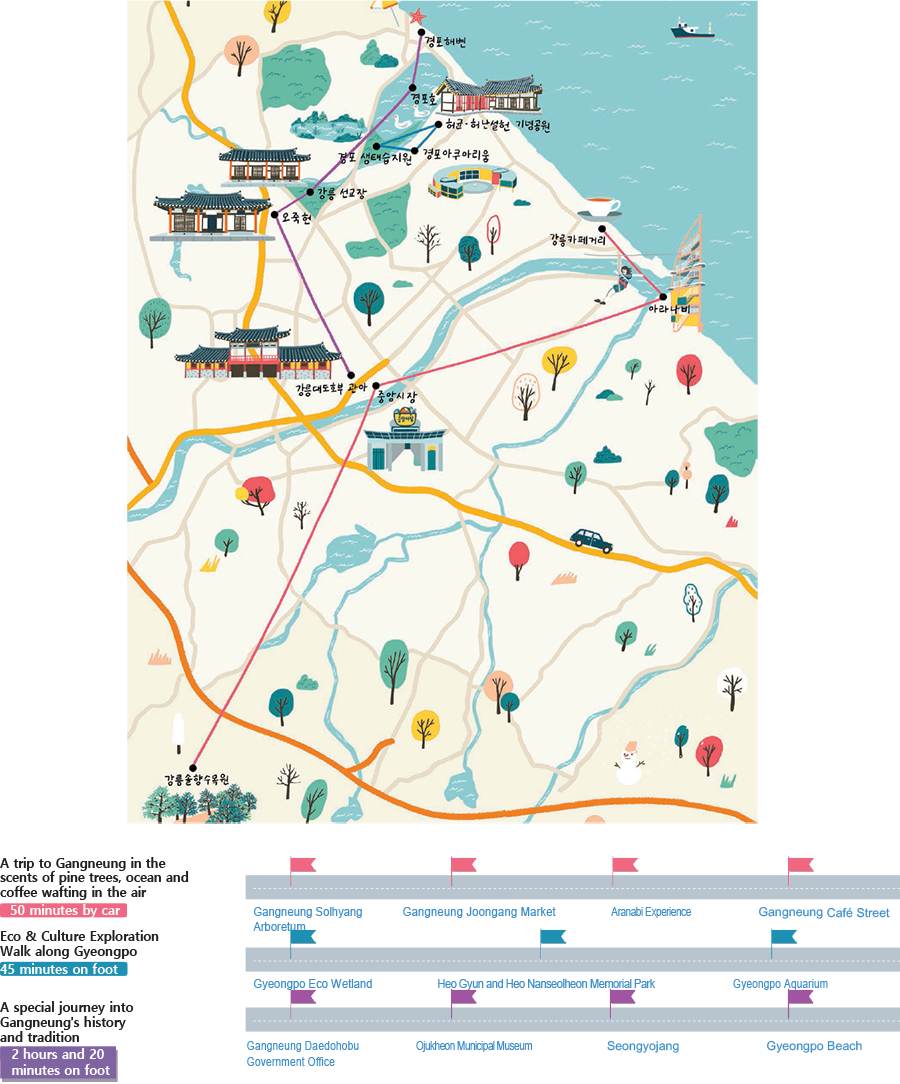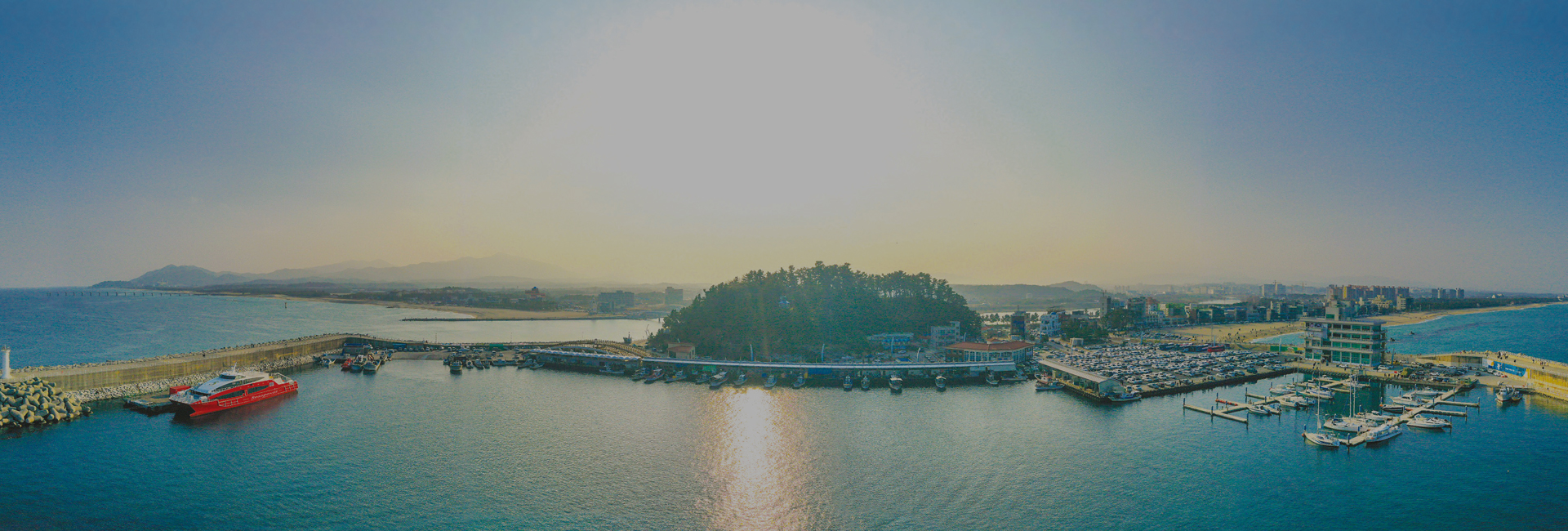
- Water, Nature and Humankind
- Travel for Save the Earth
-
 ‘Eco-Tourism
‘Eco-Tourism
Conservation Zone’
Gyeongpo Gasiyeon
Wetlands and Gyeongpo
Lake in Gangneung
Made all the more special after being restored
- Text and photo by. Lee Si-mok(travel writer)
- I was pleasantly surprised to learn that Gangneung was an eco-city. Not only was it the first low-carbon, green city in Korea—it was also a city of miracle that has restored “gasiyeon” or prickly water lilies under a wetland restoration project. So I set out on a journey. Coffee, soft tofu, and sunrise are some of the iconic images that come to mind at the mention of Gangneung. I deleted these images from my mind and instead held on to a single keyword—“ecology”—as I set foot on the city. Guided by the word ecology, I was first led to the two lakes—Gyeongpo and Soonpo—and then to the wetlands in Dongmyeong. Interestingly, there were a beach and a stream also named “Gyeongpo” in Gyeongpo, and these were great walking paths. This time, let’s go on an eco-journey to Gangneung, more specifically to Gyeongpo. If you keep your voice down and take a leisurely stroll, you will be able to make sense of all the movements of creatures whose life depends on Mother Nature and to hear the sounds they make.

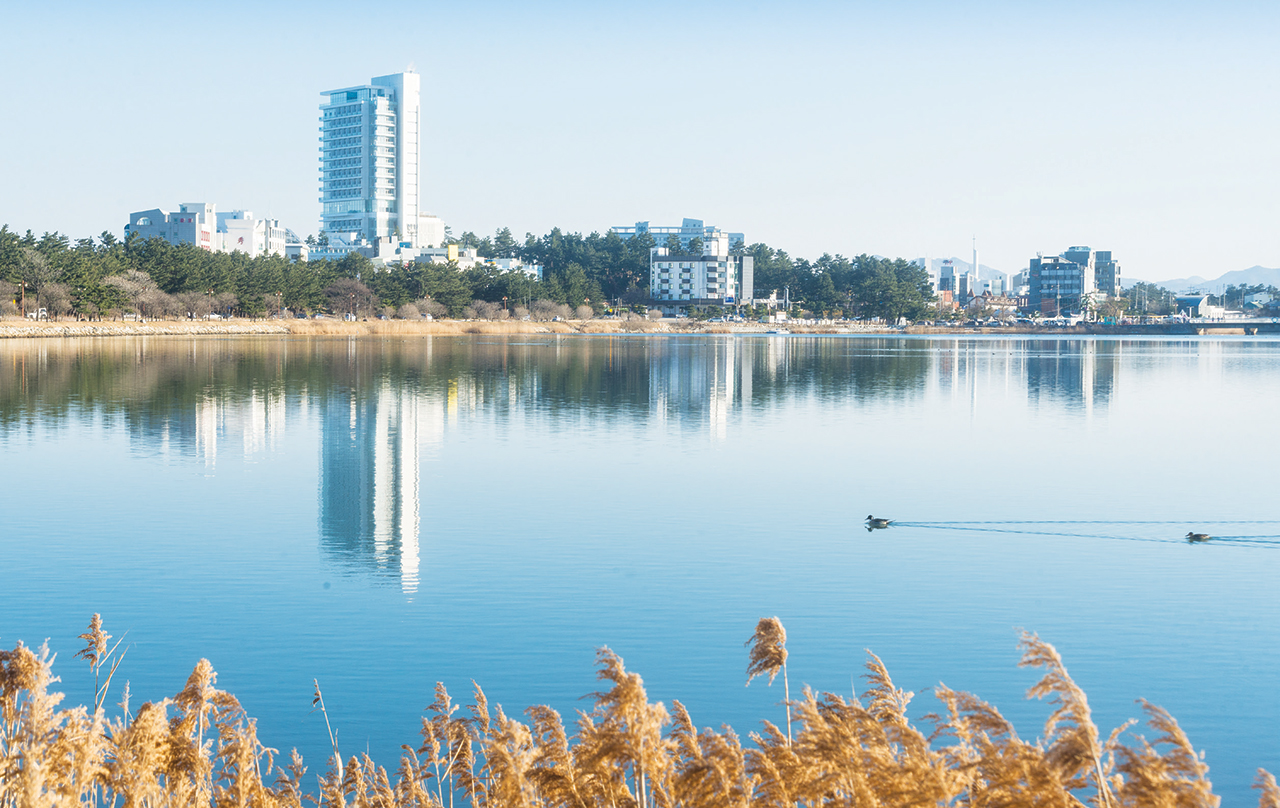 1. A reflected image of downtown Gangneung on Gyeongpo Lake. A flock of birds fly by over the reflection, stirring up a series of ripples
1. A reflected image of downtown Gangneung on Gyeongpo Lake. A flock of birds fly by over the reflection, stirring up a series of ripples
Reduce carbon emissions and make Earth greener
Gangneung is known for different things including literature, soft tofu, beaches, and sunset. Recently, it has also become popular as a city of coffee. In addition, Gangneung has created its own city brand “Solhyang,” meaning “the scent of pine trees.” Solhyang is also a slogan to promote the city’s “low-carbon, green growth” policy, which was launched in 2009. As a city brand, it has steadily grown in tandem with the city’s ecological and environmental achievements. At the heart of all these phenomenal changes is Gyeongpo.
Gyeongpo is clearly Gangneung’s ecological pivot of the huge ecological ring including Gyeongpo Lake, Gyeongpo Beach, Gyeongpo Stream, Gyeongpo Gasiyeon Wetland, and Gyeongpo Ecological Reservoir. Gyeongpo Lake was once reclaimed for development projects, becoming severely polluted as a result. However, the city of Gangneung and the Ministry of Environment worked closely together to improve the quality of water in the lake and restore—almost to their original conditions—the wetlands that had been previously reclaimed into farming fields. An ecological miracle happened in this process. Prickly water lilies, whose traces were found only in literature and stories that had been passed down orally, started to grow naturally in the lake. The seeds that had been dormant at the bottom of the soil of the reclaimed farming fields for more than half a century have finally grown into flowers as the restored wetland provides an optimal environment for germinating the seeds.
This miraculous event represents the culmination of all ecological and environmental efforts made by the city of Gangneung under the slogan “low-carbon, green city.”
More creatures have returned to the area aside from prickly water lilies. Various aquatic and marsh plants started to grow, providing a great habitat for fish, which in turn has attracted a growing number of birds and mammals preying on the fish. Now, you can see migrating birds diving in the water for fish at the lake. Among the birds that return to the lake every year after the restoration project was completed are whooper swans, an endangered species (Type II) designated by the Ministry of Environment and the flagship species of the Gyeonpo Gasiyeon Wetland Restoration Project. “Swans have come back to the lake this year as usual. They are often seen at the lake, around the wetlands, and even in nearby farming fields,” an official from the Gangneung Eco-Tourism Association said.
“A Sneaky Visit” to the Wetlands along the Observation Path
The first destination was the wetlands. The back swamp of Gyeongpo Lake was restored in 2012 and is officially known as Gyeongpo Gasiyeon Wetland. It was previously known as Gyeongpo Wetland but was renamed after gasiyeon or prickly water lilies started to grow again there following the restoration.
The wetland is divided into 4 main areas aligned from west to east along the flow of water. With the wetland water reservoir located at the west end, the source of prickly water lilies, the water- purifying wetland, and the lotus garden stretch eastward along the water flow path. The wetland water reservoir contains fresh water, with the water-purifying wetland serving as a habitat for water-purifying plants including cattails and water hyacinths. The source of prickly water lilies and the lotus garden, as the names suggest, are home to blooming lotus flowers. In fact, prickly water lilies first began to grow at the source; today, a growing number of colonies are growing elsewhere in the lake. Too bad lotus flowers are currently not in season. The prickly water lily habitat is now all frozen; only the brown, withered lotus stems provide a glimpse of how beautiful the lotus garden must have been at the peak of the lotus-blooming season. When spring comes, all the plants will wake up from their slumber and grow again here.
These habitats are well-aligned and connected organically along the observation path. The path is located at an optimal distance—neither too far nor too close—from the center of the wetland, allowing visitors to be able to explore every nook and cranny of the wetland without posing any threat to the birds and animals. Perhaps that is also the distance required between humans and nature in order for them to coexist peacefully.
-
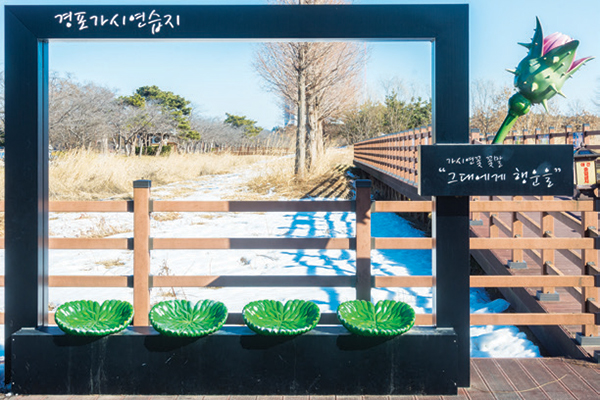 2. A photo zone set up at the source of prickly water lilies in Gyeongpo Gasiyeon Wetlands
2. A photo zone set up at the source of prickly water lilies in Gyeongpo Gasiyeon Wetlands
-
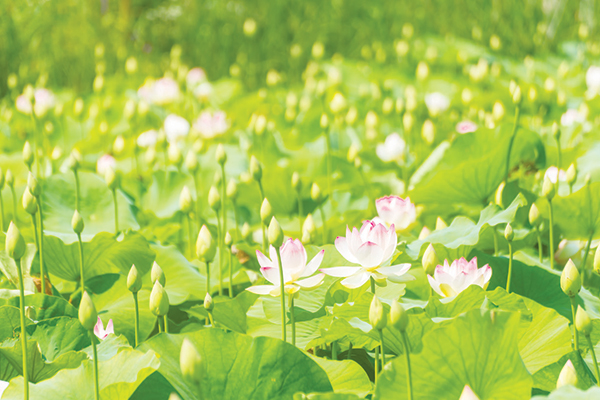 3. In summer, the wetland turns into a giant lotus garden with beds of red and white lotus flowers in full bloom.
3. In summer, the wetland turns into a giant lotus garden with beds of red and white lotus flowers in full bloom.
Lives Nurtured by a Lagoon
A great egret is flying over a lake. A mother and a daughter are having a long, nice chat, and a few bicycles pass by. Moms and dads push strollers for their babies as they walk along the observation path against the picturesque sunset. Birds sometimes hover around the path for food. Watching mergansers and pin-tailed ducks going underwater to catch fish for a while, I realize that in Gyeongpo, people and nature coming in contact form part of everyday life. An ecosystem that is peaceful and free from any threat is such a source of comfort for humans as well as for plants and animals.
A low-carbon, green city means a city with low carbon emissions. In other words, it seeks to achieve zero emission eventually by reducing carbon emissions and expanding green spaces that can absorb carbon dioxide. Sitting on the restored wetland and walking around Gyeongpo Lake filled with clearer and cleaner water, I thought about ecology and coexistence. I spent the entire day thinking about what tourists can do to protect and preserve the flora and fauna growing in the bosom of Gyeongpo Lake.
- Four Promises to Preserve
Gyeongpo Gasiyeon Wetland - Visitors’ rules to follow for the peaceful coexistence of mankind and nature
-
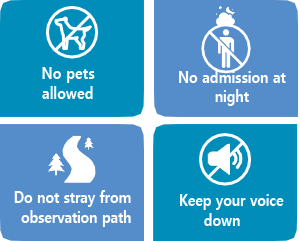
-
Here are some tips on how to make your visit to Gyeongpo Gasiyeon Wetland more fun.
‘Gangneung Eco-Tourism’
The program is designed and run by the Gangneung Eco-Tourism Association. The key feature of the program is to travel in ways that minimize harm to nature. For example, the traveling distances between destinations and use of disposable items are minimized to reduce carbon emissions and conserve resources. The program includes Gangneung eco-learning tour, visit to Gyeongpo Gasiyeon Wetland, healing stories, watching of migrating birds, eco-surfing, and bike tour around Gyeongpo Lake. Eco-surfing combined with eco-plogging (picking up trash at wetlands and beaches) is especially popular among tourists. Discover what peaceful coexistence is all about while enjoying your trips to beaches and wetlands. You can join the program by visiting the website of the Gangneung Eco-Tourism Association at www.gnecotour.com or calling 033-923-0299.
 Gangneung’s Top Attractions
Gangneung’s Top Attractions
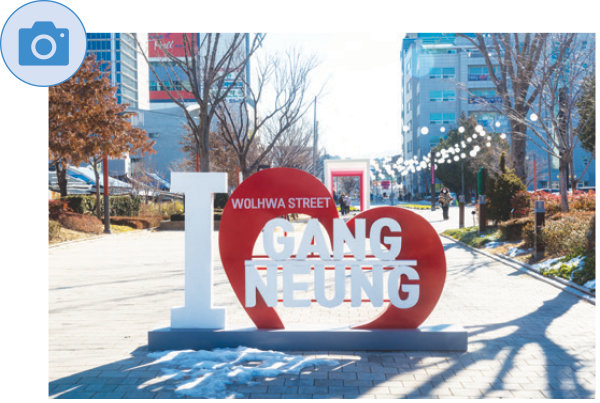
-
Life at a Slow Pace in Old Downtown Gangneung
Weolhwa Street
Weolhwa Street is a 2.6 km-long walking path where you can walk and check out places in old downtown Gangneung. It stretches from Gangneung Station to Weolhwajung forest trail. Also on the path are Malnaneumgteo Park, Healing Forest Trail, Imsadang Plaza, History & Culture Plaza, Life and Culture Plaza, and Weolhwa Bridge Observatory. Life and Culture Plaza in Gangneung Joongang Seongnam Market is the most popular tourist attraction. Lovely photo zones are scattered across the area, and various specialty and gourmet restaurants are drawing tourists to the area. People willingly wait in long line to taste some of the most popular local specialty snacks including sweet and sour fried chicken, hotteuk served with ice cream, garlic-flavored bread, and fish croquette. The streets look even more charming at night with the warm and enticing glow of lights.

-
A Museum of Lights
Arte Museum Gangneung
Giant waves come crashing right at your feet, and twinkling stars look as if about to fall over you. It is a description of a scene displayed at Arte Museum Gangneung, which opened in Chodang-dong last December. The museum features 12 different spaces showcasing various images of Gangneung as expressed in lights under the theme of “valley.” The Garden Hall features songs by traditional Korean opera singer So-hee Song, and the Beach Hall showcases the unlimited expanse of a beach. Every inch of the 10m-high building including the walls, floors, and columns is covered with images and videos, creating a spectacular showcase of lights.
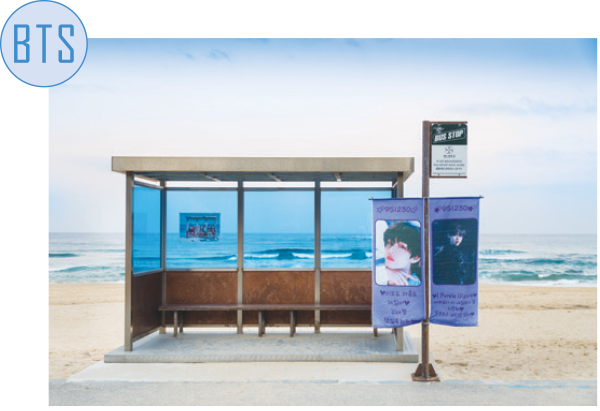
-
A filming site for the BTS album jacket
Hyangho Beach
Connecting to Jumunjin Beach, Hyangho Beach is better known for what is called the “BTS bus stop.” It is not a real bus stop but a fake one set up while filming the jacket of the BTS album “You Never Walk Alone” released in 2017. It was removed after the shoot, but the city of Gangneung reinstalled it as a photo zone. It makes for the perfect photo spot with a swing and a heart-shaped bench. A smart phone holder is available in front of the bus stop to help visitors take selfies.

-
Indulge in coffee aroma
Anmok Beach
Gangneung is full of amazing scents. You can smell the scents of salty ocean, refreshing pine trees, and freshly brewed coffee. After finishing your meal, let the enticing aroma of coffee guide you to Anmok Café Street, the mecca of Gangneung coffee. Dozens of specialty coffee shops line the 500m-long street along the coast north of Gangneung Port (previously known as Anmok Port). You can enjoy a fabulous ocean view while drinking coffee at most of these cafes. If you want to feel the chilling winds and smell the winter beach, getting a cup of coffee from a vending machine is probably a better idea. You can go out to the beach and step on the white foam while enjoying a warm cup of coffee.
 List of Tasty Eateries in Tongyeong
List of Tasty Eateries in Tongyeong
-
-
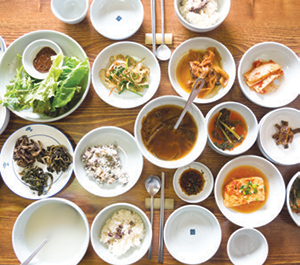
-
Seoji Chogatteul
The restaurant serves a traditional Korean-style course meal cooked with 300-year-old secret family recipes. It is widely known as a place where you can enjoy a feast of authentic local foods. The basic course is “Jilsang” that serves, among others, a variety of pickled vegetables and namul (seasoned vegetables), bugak (seaweed and vegetable chips), and ssijongji rice cake. The soft and chewy rice cake is especially popular.
-
-
-

-
Umjinae Pocha
People wait in line to eat at this place even on weekdays. “Bibimbap with seasoned cockles” is the signature dish of this restaurant. Cockles are prepared and boiled to be mixed into the secret sauce. The seasoned cockles are then spread and pressed thinly on a large plate. Together, the spicy sauce and sesame oil create a perfect combination of uniquely Korean flavors and aroma.
-
-
-
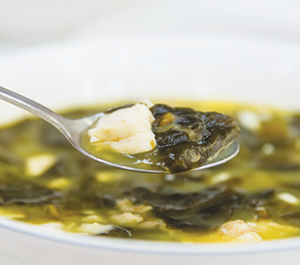
-
Jangan Raw Fish
As one of the many cold raw fish soup restaurants located around Sacheonjin Port, the restaurant has been operating at the same spot for more than 20 years. A bowl of cold soup comes with a generous amount of sliced squid, round-nosed flounder, and flatfish, all of which are fresh and raw. The seaweed soup cooked with flat fish meat is also popular for its thick, rich broth. The soup that takes hours to cook is definitely a healthy and tasty choice.
-
-
-
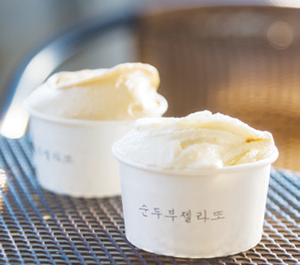
-
Soft Tofu Gelato
No. 1 dessert representing Gangneung. Branch No. 1 is in Chodang-dong, and Branch No. 2 is in Anmok Beach.
The dessert store offers a wide variety of choices including soft tofu gelato—a perfect combination of tofu’s nutty flavor and sweet ice cream—and injeolmi (a type of Korean sweet rice cake) gelato with the subtle flavor of nutty roasted bean powder.
-
Enjoy Gangneung to the fullest
Walk on the three themed trails that bring together the beautiful nature and local culture of Gangneung.
